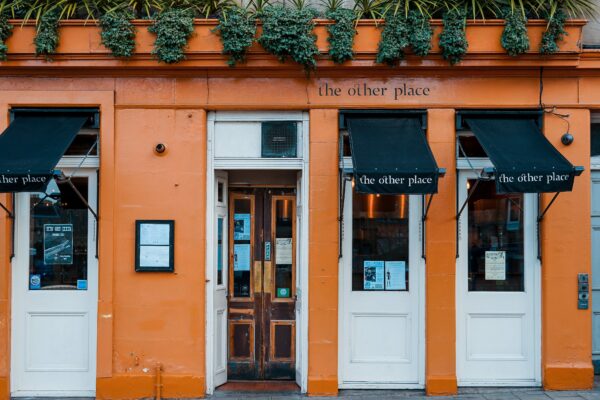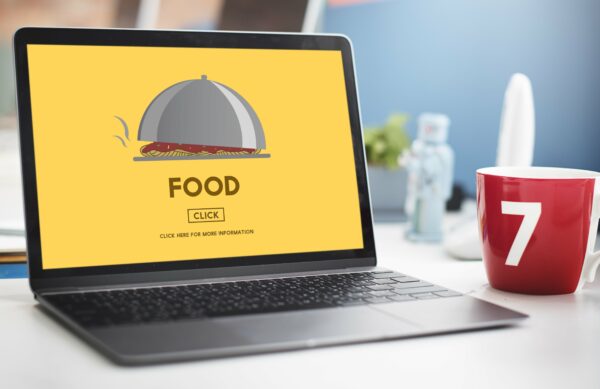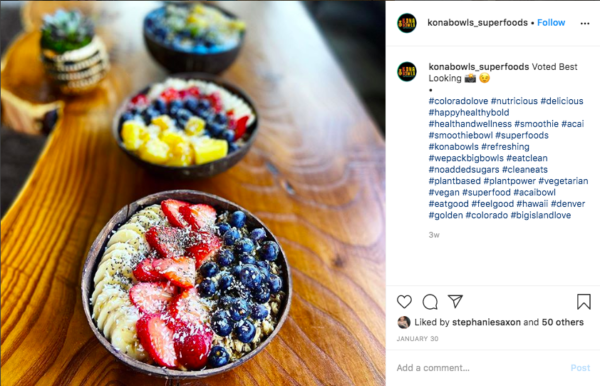A 10-Step Restaurant Branding Checklist

Hungry to start a restaurant of your own? Or looking to rebrand? Time to fill up on restaurant branding tips!
A well-established restaurant brand sets the tone for your food, differentiates you from competitors, and encourages people to come back for more.
Take a moment and think about your favorite restaurants, bars, or cafes. What brings you back every time? Is it the type of food or drink? The location? Maybe it has a unique ambiance. Or it’s your favorite because you feel valued as a customer. Believe it or not, all of these questions tie back to branding.
We’ve created an easy to follow checklist for restaurateurs looking to start their first (or upgrade) restaurant. Whether you’re planning to open a bakery, cafe, bar, or bistro, this checklist is for you.
1. Create your mission statement

Think of your mission statement as the bread and butter of your restaurant brand. This is more for you to use internally as you plan your restaurant behind the scenes.
A well thought out mission will set the foundation for your restaurant, provide insights to your business strategy, and guide all business decisions. More importantly, your mission statement explains why your business exists.
A perfect example of a well-constructed mission statement is by Starbucks:
This mission statement reflects what the company does to keep its business running. In very few words Starbucks communicates its goal for customers, employees, and global impact. Note that this mission statement is sufficiently abstract— making it applicable to future business scenarios. Ultimately, this mission statement is focused on creating a consistent customer experience.

When creating your mission statement, you’ll want to consider these 5 characteristics:
- Keep it short
- Make it transparent
- Be honest
- Unique
- Actionable
Once you have your mission statement set, keep it somewhere visible! That way you and your team can refer back to it throughout the process of developing your brand. Companies that honor their mission and remain consistent are more likely to see growth and future success.
2. Cook up your brand personality
Now that you have your mission statement, it’s time to bring your restaurant’s brand to life. An established brand personality will shape the way people feel about your service and create an emotional connection with your brand. Customers are more likely to pursue a brand if their personality is similar to their own.
Develop your brand personality by first telling your company story. Your brand story can show how your restaurant came to life and why you decided to open a restaurant. This will help differentiate you from competitors and give context to your brand.

Take Northshea for example. This beauty company uses ethically source shea butter to create incredible products that employ Ghanian women in rural Ghana by paying them double the standard wage and providing ample opportunities to enrich their lives.
A purposeful story like this grabs your ideal guests’ attention and activates their emotions. It also develops trust—this brand is run by people who have actually lived in Hawaii and immersed themselves in the food and culture.
3. Pick a demographic and location

Like a fork and knife, your demographic and restaurant location go hand in hand. Before making any major business decisions, like signing the lease to your new restaurant, you’ll need to establish your target audience. Think back to your mission statement and brand personality. When establishing those, who did you imagine walking through your doors?
To start, familiarize yourself with different demographic characteristics like age, gender, or level of income. Did you envision your restaurant becoming the hot new date-night spot, a meetup location for business professionals, or perfect for family bonding?
You’ll also need to consider your price-point and how much you wish to charge your customers. Though some may be alright with paying a pretty penny on a good meal, others will be deterred by hefty prices.

Once you have a good idea of your target audience, you can start scouting a location. More often than not, restaurants fail because the owner(s) didn’t put enough time into researching neighborhoods that suited their desired demographic. Perhaps you’re targeting families, but you chose a location in your city’s financial district. The demographics in that area will be largely business professionals and far from residential areas with families.
Another important consideration when choosing a location is market saturation. You don’t want to open up a Mexican restaurant if there’s already three or four of them on the same street. Get to know what else is being offered in the area and see if your idea will stand out or be drowned out.
4. What’s on the menu?

Time to talk about the important stuff, food. Don’t be “hangry” if you haven’t got your menu set in stone yet. This is often an ongoing process for many restaurants and requires a lot of trial and error.
The ideal restaurant menu offers a balance of unique meals and classic dishes. Your menu is one element of your brand that your customer seeks out and comes into contact with more than anything else. Think about your own experiences in choosing a restaurant to dine at. Do you simply walk into the first one you see, or do you browse multiple menus until you find the one that’s right for your appetite?
Your menu should act as a reflection of your mission statement and personality. Offering every type of cuisine under the sun won’t cut it.

For example, are you the kind of establishment that wants to adhere to certain dietary restrictions like plant-based diets? Maybe you’re the type of business that wants to be more sustainable and attract people with your ethically sourced produce?
You can also communicate the story of your restaurant through the overall layout and design of your menu. As the saying goes, “you eat with your eyes first,” so a well-designed menu will go a long way for your restaurant.
5. Craft a compelling name

Whether you already have a name or you’re still in the brainstorming stage, your restaurant name should be appropriate and eye-catching. It needs to tell the story of your brand and communicate your mission statement to everyone that sees it.
Your restaurant name should do the following:
- Give context to the kind of food you offer
- Provide a sense of atmosphere
- Be easy to remember
Giving your business a name should be exciting! A clever pun is certainly one of the more humorous ways to come up with a cool restaurant name. Not only are they memorable, but they reflect the personality of your brand. Some real-life examples of pun-based restaurant names are, “Wild Thyme Café,” “Tequila Mockingbird,” or “Life of Pie.”
If you need some help with coming up with a catchy and creative business name, check out our blog.
6. Design a logo that’s good enough to eat
Once you’ve come up with a tasty company name, you’ll need a logo to go with it. Your restaurant logo should convey the kind of atmosphere guests will experience at your establishment.
Your logo should be strong enough to be visible from the outside of your restaurant as a way to entice people indoors. Make sure to create a logo that is legible and can be printed on various mediums like menus, windows, doors, napkins, signs, etc.
If you’re in need of some inspiration to get your creative juices flowing check out our restaurant logo page.
Create your very own logo with our AI-powered logo maker. It’s free to try!
7. Dream up your restaurant interior

Source: blog.flyporter.com
Your restaurant interior should be unique to your brand. Is your brand classy, traditional, and upscale? Is it trendy, urban, and contemporary? Maybe it’s mirroring a specific culture. Or maybe it’s going for home-style comfort. Either way, your interior sets the tone for a customer’s entire experience at your restaurant. A whitepaper found that 91% of restaurant-goers say that an appealing ambiance influences their decision to visit a particular concept.
Looka customer, Cafe Dolce is a perfect example of an establishment that makes use of their space correctly. Their space communicates a casual atmosphere where you can grab a coffee with a friend, sit and work, or even read a book.
If you’re in need of some ideas for decorating your restaurant, Pinterest is a great resource for gaining inspiration.
8. Focus on customer service and training
As a restaurant owner, great customer service is essential to your business’s success. A company’s reputation, and therefore its bottom line, literally rests in the hands of anyone with a smartphone. 84% of customers trust online reviews as much as personal recommendations. That means that if your business is backed by positive reviews it’ll create more confidence in a prospective customer.

One of the most important ways to promote a positive experience for your customers is through your customer service training. Your people are your brand, and how they behave and treat your customers will have a direct effect on the brand experience. Your staff should be familiar with your mission statement and understand the story behind it. If they have a deep understanding of the who, what, and why that’s driving it, they will take greater ownership of delivering it.
9. Consider restaurant events

Your restaurant offerings don’t need to stop at just food and drinks! A fun way to build your brand and bring people to your establishment is through events. For example, scheduling live music consistently at your restaurant gives you events to promote and makes your restaurant look like the place to be. Some other events to consider are:
- Karaoke
- Trivia
- Dancing
- Paint nights
- Panels and talks
- Open mics
- Poetry readings
10. Develop your online presence

Now that your brand is sorted, you’ll need to get your business online before you can start marketing your restaurant! Often, your guests’ first impression of your restaurant will be through your website or social media. That means that your online presence should match the experience your customers get when they walk through your doors.
Your website doesn’t need to be perfect, but it does need to be user-friendly. If your website is hard to manage and navigate, it’s more likely to turn customers away rather than pulling them in. To ensure you’re launching a site that’s secure, easy to use, and full of useful content check out this website checklist.
Online, your guests will be interested in seeing:
- Your menu
- Food and drink prices
- Photos of food
- Photos of the space
So be sure to make this information readily available to your online guests!

Once your website is ready to go, your social media channels should naturally follow. The ability to build and raise your social media branding — and execute the same visual aesthetic across social channels — has become a major asset to a growing company. A strong social media presence will allow you to connect with potential customers, and engage your community of followers.
Time to get cookin!
Simply put, your restaurant brand is the foundation of your entire business experience. Every decision you make must tie back to what you do, who you are, and why you’re doing it. In order to create and maintain a clear and consistent brand message, you must obsess over details. Keep your mission statement and brand personality in mind at all times. With a well-established brand, your restaurant is destined for growth and future success!



